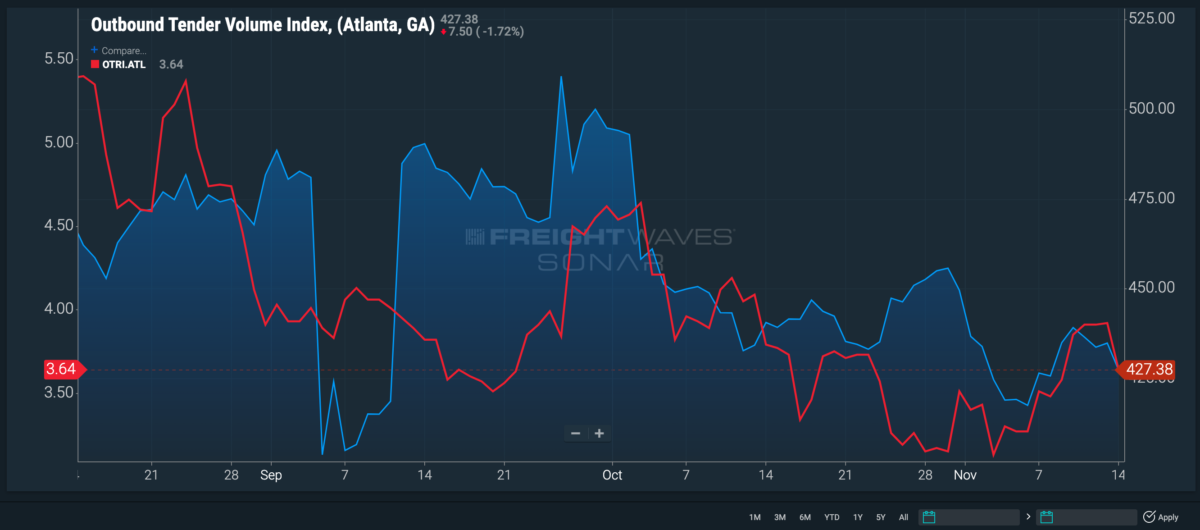The highlights from Tuesday’s SONAR reports are below. For more information on SONAR — the fastest freight-forecasting platform in the industry — or to request a demo, click here. Also, be sure to check out the latest SONAR update, TRAC — the freshest spot rate data in the industry.
Market Watch for Nov. 15:
Atlanta
Atlanta was outperforming other markets last week with a 5.1% increase in outbound demand, but this week is trending down with all the others.
The Outbound Tender Volume Index in Atlanta slumped nearly 2 points over the weekend — not a big surprise there — but lost more ground at the start of the week by falling an additional 7 points, or 1.7%. The drop in volumes brought Atlanta’s Outbound Tender Market Share down from 4.03% to 3.96%, but it still remains well above Ontario, California, with 3.23%.
Rejection rates in the Empire of the South were moving up as volumes grew last week, climbing to 3.9%, but the recent decrease brought a sharp decline. The Outbound Tender Reject Index fell 28 basis points to 3.6% as more carriers are settling into their contracted tenders to secure loads.

Elizabeth, New Jersey
Outbound truckload volumes in Elizabeth, New Jersey, are getting close to yearly lows as container imports to the Port of New York and New Jersey struggle to crawl out of their lowest levels since October of last year.
Like in many of the other major markets across the nation, Elizabeth saw a significant drop in outbound truckload demand at the start of November, falling 14.2% by Nov. 3. Last week volumes were a bit stagnant but this week are taking another tumble. The Outbound Tender Volume Index for Elizabeth lost more than 12 points, or 4.5%, leading into the weekend and lost another 6 points, or 2.3%, on Monday, bringing the index to 251.62 — its lowest value in three months.
The seven-day moving average of U.S. customs maritime import shipments to the Port of New York and New Jersey dropped 52.2% from Oct. 8 to Nov. 8. Since then, the average for import shipments is up 34.5%, but it will take some time for this boost in imports to bleed into surface transportation markets.
Rejection rates have been strong for most of the year — floating anywhere from 6% to 7.5% — as the East Coast ports were gaining more import market share, but the strong decline that took place last month brought rejection rates down to their lowest levels since April 2020. The Outbound Tender Reject Index fell 52 bps since the start of November to 3.4% and is down 270 bps in the last two months.
NTI as a point of reference
The National Truckload Index is a daily look at how spot rates in specific lanes hold up in comparison to the national average, giving carriers and brokers an idea of which lanes to gravitate toward or avoid.
Lane to watch: Atlanta to Columbus, Ohio
Spot market rates from Atlanta to Columbus, Ohio, are down 9 cents since the start of November, but Columbus is one of the only major markets seeing an increase in outbound volume this month.
This lane is currently paying $2.12 a mile — 32 cents below the national average — but outbound demand in Columbus is up 11.5% since the start of the month. That’s not an ideal rate going in, but this will place carriers in a market with a better position in terms of volume.
Rejection rates out of Columbus ticked up this week to 3.5%, and a return trip to Atlanta is currently paying $2.96 a mile — 52 cents above the national average. If rejections continue to rise, further upward pressure on spot rates out of Columbus should rise with them.
